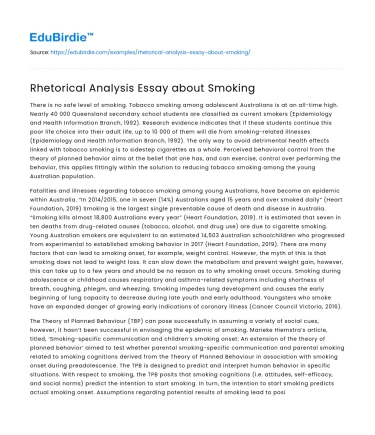There is no safe level of smoking. Tobacco smoking among adolescent Australians is at an all-time high. Nearly 40 000 Queensland secondary school students are classified as current smokers (Epidemiology and Health Information Branch, 1992). Research evidence indicates that if these students continue this poor life choice into their adult life, up to 10 000 of them will die from smoking-related illnesses (Epidemiology and Health Information Branch, 1992). The only way to avoid detrimental health effects linked with tobacco smoking is to sidestep cigarettes as a whole. Perceived behavioral control from the theory of planned behavior aims at the belief that one has, and can exercise, control over performing the behavior, this applies fittingly within the solution to reducing tobacco smoking among the young Australian population.
Fatalities and illnesses regarding tobacco smoking among young Australians, have become an epidemic within Australia. “In 2014/2015, one in seven (14%) Australians aged 15 years and over smoked daily” (Heart Foundation, 2019) Smoking is the largest single preventable cause of death and disease in Australia. “Smoking kills almost 18,800 Australians every year” (Heart Foundation, 2019). It is estimated that seven in ten deaths from drug-related causes (tobacco, alcohol, and drug use) are due to cigarette smoking. Young Australian smokers are equivalent to an estimated 14,503 Australian schoolchildren who progressed from experimental to established smoking behavior in 2017 (Heart Foundation, 2019). There are many factors that can lead to smoking onset, for example, weight control. However, the myth of this is that smoking does not lead to weight loss. It can slow down the metabolism and prevent weight gain, however, this can take up to a few years and should be no reason as to why smoking onset occurs. Smoking during adolescence or childhood causes respiratory and asthma-related symptoms including shortness of breath, coughing, phlegm, and wheezing. Smoking impedes lung development and causes the early beginning of lung capacity to decrease during late youth and early adulthood. Youngsters who smoke have an expanded danger of growing early indications of coronary illness (Cancer Council Victoria, 2016).
Save your time!
We can take care of your essay
- Proper editing and formatting
- Free revision, title page, and bibliography
- Flexible prices and money-back guarantee
The Theory of Planned Behaviour (TBP) can pose successfully in assuming a variety of social cues, however, it hasn’t been successful in envisaging the epidemic of smoking. Marieke Hiemstra’s article, titled, ‘Smoking-specific communication and children’s smoking onset: An extension of the theory of planned behavior’ aimed to test whether parental smoking-specific communication and parental smoking related to smoking cognitions derived from the Theory of Planned Behaviour in association with smoking onset during preadolescence. The TPB is designed to predict and interpret human behavior in specific situations. With respect to smoking, the TPB posits that smoking cognitions (i.e. attitudes, self-efficacy, and social norms) predict the intention to start smoking. In turn, the intention to start smoking predicts actual smoking onset. Assumptions regarding potential results of smoking lead to positive or negative frames of mind towards smoking, convictions about the regularising smoking beliefs of significant others lead to social standards, and convictions about the presence of variables that may encourage or avoid smoking lead to refusal self-viability of smoking (Hiemstra, Otten, Van Schayck, & Engels, 2012).
Hiemstra’s aim throughout the study was to assess whether “distal smoking-specific maternal communication (i.e. frequency and quality of communication) and parental smoking is important in shaping children’s smoking cognition” (Hiemstra, et., al, 2012). The study predicted that the links present in past adolescent literature would similarly align with preadolescents also. This link to previous adolescent literature relates to the commencement of smoking as a child and smoking-explicit correspondence relates indirectly to smoking commencement through smoking cognitions (Hiemstra, et., al, 2012). In relation to parental smoking, it was predicted that this would create a link to child smoking onset directly and indirectly by smoking reasoning (Hiemstra, et., al, 2012). Researchers tested for contrasting effects on incidence and quality of communication between adolescents and mothers. Through the TPB and the behaviors connected to adolescent smoking with “smoking – specific parenting practices and corrected for data collection method (phone vs. questionnaire)” (Hiemstra, et., al, 2012). Some parents may overemphasize their parenting skills to conform to the norm of being a ‘good’ parent. Therefore, it is vital to study how children perceive their parents, and parenting practices.
In sum, the current findings suggest that during preadolescence, smoking-specific communication between parents and parents’ own smoking behavior contribute to the formation of smoking cognitions prior to smoking onset (Hiemstra, et., al, 2012). At this young age, only pro-smoking attitudes were associated with smoking onset. However, several studies have shown that also self-efficacy and social norms are associated with smoking onset later in life. Present findings suggest that cognitions that increase the likelihood of smoking onset in adolescence may already take place years before actual smoking onset. Therefore, prevention programs, such as Smoke-free Kids aimed at families with children in primary school are important in stimulating communication about smoking.






 Stuck on your essay?
Stuck on your essay?

